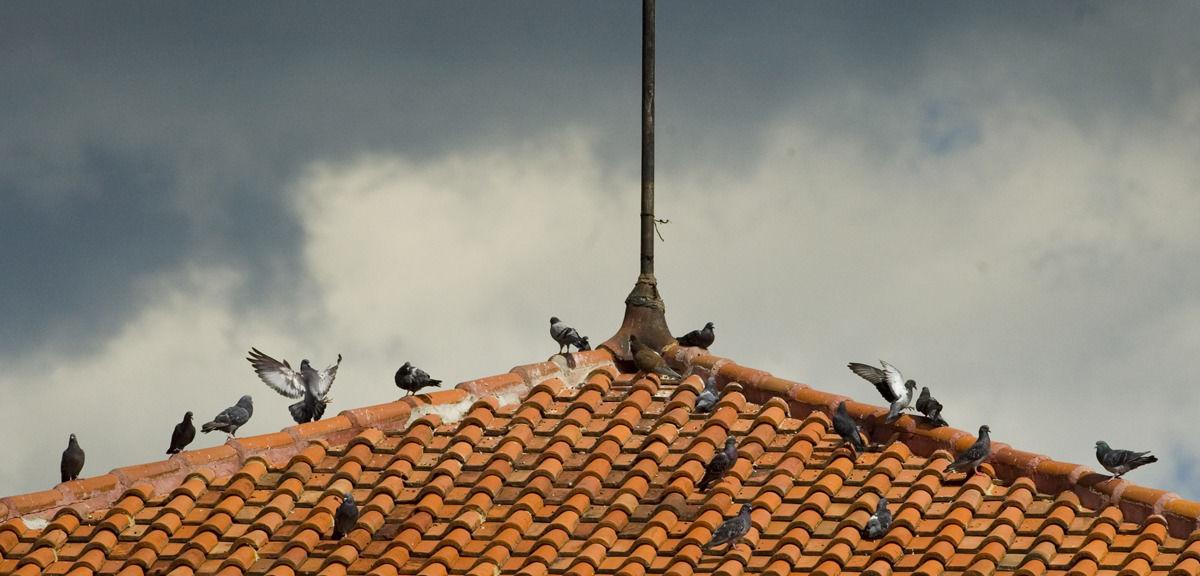
Dear Ken: I have pigeons nesting under my porch roof overhang. Help! How can I send them someplace else? — Debbie
Answer: It’s a mystery why pigeons pick out one house in a neighborhood and ignore the others. But, once they do, they are very persistent.
Sometimes all it takes is chicken wire to deter them. Use a staple gun to secure the wire to the fascia boards and soffit as a barrier to their roosting enclaves.
Another approach is to try a spray-on repellent or gel product such as Bird-X or Repels All (full disclosure: the latter is one of my radio show sponsors). They last several months and are quite effective.
Finally, in desperation, my son in Phoenix hired a company to install nail-on strips of metal bird spikes under each eave; he hasn’t seen a pigeon since.
Dear Ken: My disposal just sits there and hums. I’ve tried the broom handle trick to get it to spin, also pushing the red button and turning it with the crank. It does rotate but won’t turn on. — Greg
Answer: It’s time for a new one. You can buy a decent disposal for less than $100. You’ll be surprised how much more efficient it’ll be. That’s because disposal blades dull gradually so you don’t notice their diminished performance. This is a fairly easy job for two people: one holds the new unit at the bottom while the other turns the whole thing so it nests into the collar under the sink drain.
Most importantly, don’t forget to connect the ground wire from the cord to the green screw inside the disposal. Also, check the outlet in the wall with a polarity tester to make sure it’s wired properly. In some older homes, there can be a three-prong outlet that is not actually grounded.
Dear Ken: I took out a shower door to replace it. The previous owner had used silicone around the frame. How can I remove the leftover residue? — Frank
Answer: Rubber silicone is easy to strip off in ribbons; just start tugging on one end, ease a putty knife underneath and pull. The remaining residue usually will respond to mineral spirits rubbed on with a rag. Ventilate the area and take frequent breaks for fresh air.
For painter’s caulk — such as old hardened acrylic — 3M and other companies make a gel-like caulking remover that works pretty well.
Dear Ken: I’d like to add a floor and maybe eventually a room in the attic space. Can you help me with insulation and ventilation issues? — Ron
Answer: There’s a bigger problem. The trusses in the attic were engineered to hold the weight of the roofing (plus an appropriate snow load) and the drywall below. If you want to add loads, such as a new floor plus items you want to store, you might exceed the design limits of the trusses. One indication you’ve done so is the emergence of cracks in the drywall, as the trusses sag under the load.
There is a built-in over-design though, which means you’ll likely be OK if you go easy. Lay down a half-inch plywood floor and then only use the space for lightweight items such as empty suitcases, skis, Christmas decorations and empty boxes; avoid books and other heavy stuff. If you still want to put an actual room up there, check with a structural engineer who might be able to design some “beefing up” of the trusses and ceiling joists.
Dear Ken: We’re finishing our basement. We are carpeting most of this new area, and they want to sell us a carpet with a moisture barrier on it so spills don’t penetrate the pad. Is that OK? — Danny
Answer: I wouldn’t do it. It’s important that the concrete floor in the basement be allowed to breathe. In most homes, there is invisible moisture that wants to escape into the drier air environment of the basement space. It comes up through the floor and even through the concrete walls (that’s why I don’t recommend a vapor barrier on any wall insulation down there). I’m not talking about standing water but simply small amounts of vapor that, if not allowed to escape, can lead to damp conditions under your carpeting or inside the walls. So use carpeting with a regular backing such as jute; it’ll likely save you money anyway.
Dear Ken: I want to take a glued-on mirror off the bathroom wall with a minimum amount of damage. Any tips? — Marie
Answer: First, cover the entire surface with crisscrossed layers of duct tape. Use fine wire to “saw” back and forth, starting at one corner. You then might be able to ease a large putty knife behind it to pry it off the wall. Once it starts to release, it might pop off suddenly so make sure you have an assistant who can help hold it in place.
If it won’t budge, you’ll have to break it with a hammer. The duct tape will hold it all together so the refuse will be manageable, small chunks of glass. Wear a long-sleeved shirt, gloves and goggles to protect yourself.
Ken Moon is a home inspector in the Pikes Peak region. His call-in radio show airs at 4 p.m. Saturdays on KRDO, FM 105.5 and AM 1240. Visit aroundthehouse.com
"easy" - Google News
August 21, 2021 at 01:00PM
https://ift.tt/3k7gLbE
Around the House: Pesky pigeon problem not easy to solve - Colorado Springs Gazette
"easy" - Google News
https://ift.tt/38z63U6
Shoes Man Tutorial
Pos News Update
Meme Update
Korean Entertainment News
Japan News Update
Bagikan Berita Ini














0 Response to "Around the House: Pesky pigeon problem not easy to solve - Colorado Springs Gazette"
Post a Comment